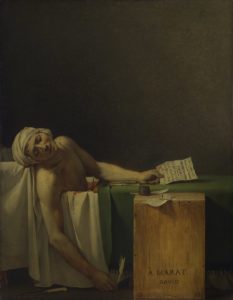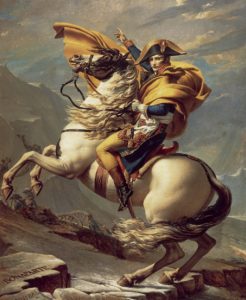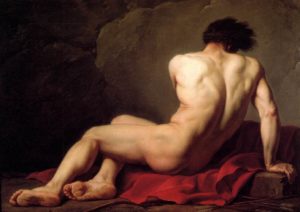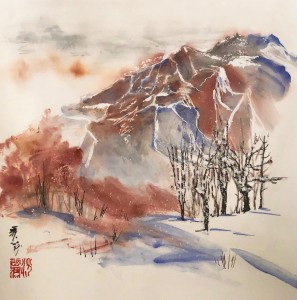Dear Artist,
Stephen King, who is 73, says he doesn’t write his ideas down because if they’re good enough, he’s unlikely to forget them. While this goes against many artists who keep notebooks and tape recorders in the car or by the side of the bed lest they forget their dreams, it works for King. “I don’t take notes; I don’t outline, I don’t do anything like that,” he says. “I just flail away at the goddamn thing.”
In painting, whether you’re a planner or a flailer, one of the most valuable things you can take from your own process is to try the opposite once in a while. Flailing for a day, for example, can get you out of a step-by-step system that may be blocking untapped, magical accidents. And forcing a flailer to plan her work should coax skills of care and technical understanding that will serve her during future flails. Here are a few ideas:
For planners:
You may be stuck in a system where your work is telling the story of your system instead of the more interesting story of your experience of the world. Forgo your imprimatura, grisaille or drawing stage altogether and attack the entire painting surface, wet into wet in one go. For this exercise, set a time limit for your painting of less than an hour — 30 minutes really should do. Abandon comfortable building blocks and instead focus on laying in shapes and zones, including lights and darks in one go. Keep it loose and keep an eye out for the surprise and delight of abstraction, surface interest, bleeds, zips and magic.
For flailers:
You may lack the discipline or understanding to work a plan and to take pains in completing each stage with technical and observational integrity, producing work that is weak in design and messaging. Look three times and take a moment to mix a few key colours with intention. Paint a tonal ground and let it dry. Now make a general plan, either on the painting surface or nearby, for where you want things to be, and design an order of operations as to how you’re going to get there. What is the message and meaning of the work? What is the ultimate vibe you’re trying to create? What do you want people to feel? It can be useful to give the work a title before you even start. Developing a process for a desired result takes time and trial and error. Prepare half a dozen grounds and see if you can build a personal system of steps that will bring you to a more thoughtful and polished work of art.
Sincerely,
Sara
PS: “It is, after all, the dab of grit that seeps into an oyster’s shell that makes the pearl, not pearl-making seminars with other oysters.” (Stephen King)
Esoterica: “Talent is cheaper than table salt. What separates the talented individual from the successful one is a lot of hard work,” wrote King. The answer is still, and will always be, work. If we are to advance our ideas and our ability to communicate them, we must find ways to develop our hard-won systems while staying loose and open to magic. Art needs the ineffable something that we cannot explain. If this all sounds like a delicate and eyelash-thin tightrope to navigate, check any skilled person’s performance at any stage of their development and their mastery. Notice the work they put in to retain and refine the art within their craft. After all these years, I’m starting to think that being relaxed could be the greatest skill of all. How do we do that? Experience, knowing ourselves, context, enjoyment, practice, love and a commitment to continuing to work on these things. “All you need to do is hold on tight… and believe.” (Stephen King)
Have you considered a Premium Artist Listing? With each letter, an artist is featured at the bottom of this page. The Premium Artist Listings are a means of connecting artist subscribers through their work. Proceeds from each listing contribute to the production of The Painter’s Keys.
“In the arts the way in which an idea is rendered, and the manner in which it is expressed, is much more important than the idea itself. To give a body and a perfect form to one’s thought, this – and only this – is to be an artist.” (Jacques-Louis David)
“When asked, ‘How do you write?’ I invariably answer, ‘One word at a time.’”(Stephen King)
Featured Artist
Los Angeles-based artist Lisa Chakrabarti works in a variety of media: oils, acrylics, pastels, watercolors, graphite and colored pencils. Focusing on a style she calls “romantic naturalism” – impressionism based largely on subjects in the natural world – her works have found their way into galleries in Los Angeles, Florida, Colorado and New York. In 1995, after being introduced to sumi-e and Chinese ink painting by Asian friends, Lisa became captivated by the apparent freedom and subtlety of this ancient medium. This shift in focus has informed her work ever since.









18 Comments
It’s clear that I need to do some serious “flailing!” Thank you for this, Sara, and for the quotes from Stephen King.
As an aside, many years ago, I quit painting completely for two years so that I could try my hand at writing. A voracious reader all my life, how hard could it be, I wondered. Well…a lot harder than it looks. Stephen King’s book “On Writing,” is for my money, the best book ever about the art and process of writing. After that two year hiatus, with one completed novel in a drawer where it belongs, I happily went back to painting!
The book ” On Writing” is the best ever .
ABSOLUTELY!!!!!
Yes – like walking a tight rope – courage is necessary. Perhaps we go through various stages and methods to a place of creating that we feel is simple yet is quite a complex expression of the individual and something beyond explaining, and is simply practiced.
Doing 37 stroke and 37 minute paintings sure helped me, thanks to you and your dad.
The consideration for artists is endless; planning and flailing are all part of it…Struggle and discovery, as in life, takes on the person doing it and becomes “a work of art.”
You can see my attempted “tightrope” painting outdoors on YouTube: https://www.youtube.com/channel/UCt_PKiq0FUAwhC614dPXzHA Thank you Sara.
Yes, being relaxed is an old story. I remember that idea from the Inner Game of Tennis. It is just so hard to do when things are not going your way. It can come and go during the game or likewise during the construction of art.
The problem is that it won’t happen when you are out of sync and want a secret amulet to turn it on. Some sort of system for setting the mood is necessary. I like music and I like to just spring into action, knowing that eventually it will come to me.
The hard part is that it may take days or years. Sometimes it can happen suddenly. Having my studio attached to my house is a big advantage. I pass through and take a jab at a recalcitrant piece, which is risky but occasionally fruitful. So far I have never been completely blocked even for a day. Would love to hear what you are doing.
This is a great blog. From someone painting for 40 years, I know the feeling of the journey without knowing where I’ll end up. Always on the lookout for interesting influences and out of the blue opportunities. Still love it.
Nothing teaches flailing better than plein-air painting. Go out in the early morning or late afternoon when the light effects are fleeting, and you’ll have no choice but to flail away!
Omg, Sara, SO GOOD. I laughed out loud at the oyster quote. Well done.
Me too. I’ve read his book and need to buy it now.
Sara, I read the entire letter thinking this was your father’s writing! You’ve captured his style so well! Of course the Stephen King quotes should have given it away! Thanks for keeping these letters coming! Now to go plan….or plan to have a plan, anyway.
I love this letter and happily do flail or plan! Both work for me, but of course not 100% of the time. Which makes it art…
In the midst of flailing I found an inspiration today. I read your letter and was struck by how it hit the nail on the head. Thank you Sara. , your father is winking down at you!
I love this letter, thank you! I think I am both, I guess more a flailer because I never have been good with directions and pre-planning. I once took a class that required we draw lines to make a grid so that the image we painted would be exact to the photo we were using. I failed gridding. I just painted the painting because that felt better than staying within the lines. In school, I got an E in Home Ec, I wanted to just sew the blouse from looking at the picture on the pattern envelope. Yes, I am a rebellious flailer in many things aside from painting. I think I have a few things not put together from Amazon because I know I will have to sit and read instructions. But you’re advice is good, always good to switch things up a bit, maybe I’ll ty to make a plan and try to follow it, always good to break out of the stuck now and then. Thanks, Sara!
Always an inviting bunch of artist’s comments. Sometimes they have such enthusiastic content that they add dimension to the creative articles.
Thanks and blessings to all concerned.
Sara, I am switching between methods, working on a systematic, step by step approach, but preparing to paint one of the largest canvases ever in multimedia. At this moment, waiting for a canvas more than five feet tall and more than three feet wide to be stretched, I don’t even know how or where I will paint it. The image and the title are in place, now for the actual work. Evolving work in the past two or three years has kept me leaping back and forth between these two approaches. It’s invigorating, releases creative tension and energy, and renews my artistic roots.
Great one! Stephen King’s stories mostly scare me too much to read, but I enjoy his quotes, thought process, and writing style. I’m a planner, so I guess I’m up for the horror (pun intended;)) of flailing.
Yes, twenty minute expressions. Or maybe five on something smaller. Can I do it in five strokes? Oooooo. ….delicious.
Flail or fail ? …. how does a baby learn to use it’s arms and legs? To hone and fine tune or be precise in any way, requires knowing our limits …. and to know our limits means failures…. on the way to successes. What is there to lose?
It’s just paint.